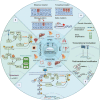Polyamines: their significance for maintaining health and contributing to diseases
- PMID: 38049863
- PMCID: PMC10694995
- DOI: 10.1186/s12964-023-01373-0
Polyamines: their significance for maintaining health and contributing to diseases
Abstract
Polyamines are essential for the growth and proliferation of mammalian cells and are intimately involved in biological mechanisms such as DNA replication, RNA transcription, protein synthesis, and post-translational modification. These mechanisms regulate cellular proliferation, differentiation, programmed cell death, and the formation of tumors. Several studies have confirmed the positive effect of polyamines on the maintenance of health, while others have demonstrated that their activity may promote the occurrence and progression of diseases. This review examines a variety of topics, such as polyamine source and metabolism, including metabolism, transport, and the potential impact of polyamines on health and disease. In addition, a brief summary of the effects of oncogenes and signaling pathways on tumor polyamine metabolism is provided. Video Abstract.
Keywords: Cancer; Disease; Mechanism; Oncogene; Polyamine metabolism.
© 2023. The Author(s).
Conflict of interest statement
The authors declare no competing interests.
Figures




Similar articles
-
Molecular mechanisms of polyamine analogs in cancer cells.Anticancer Drugs. 2005 Mar;16(3):229-41. doi: 10.1097/00001813-200503000-00002. Anticancer Drugs. 2005. PMID: 15711175 Review.
-
Polyamine Homeostasis in Development and Disease.Med Sci (Basel). 2021 May 13;9(2):28. doi: 10.3390/medsci9020028. Med Sci (Basel). 2021. PMID: 34068137 Free PMC article. Review.
-
Polyamines in mammalian pathophysiology.Cell Mol Life Sci. 2019 Oct;76(20):3987-4008. doi: 10.1007/s00018-019-03196-0. Epub 2019 Jun 21. Cell Mol Life Sci. 2019. PMID: 31227845 Free PMC article. Review.
-
Functions of Polyamines in Mammals.J Biol Chem. 2016 Jul 15;291(29):14904-12. doi: 10.1074/jbc.R116.731661. Epub 2016 Jun 7. J Biol Chem. 2016. PMID: 27268251 Free PMC article. Review.
-
Polyamines in Ovarian Aging and Disease.Int J Mol Sci. 2023 Oct 18;24(20):15330. doi: 10.3390/ijms242015330. Int J Mol Sci. 2023. PMID: 37895010 Free PMC article. Review.
Cited by
-
Metabolomics Insights into Salivary Profile in Dogs with Babesia canis Infection.Biomolecules. 2025 Apr 1;15(4):520. doi: 10.3390/biom15040520. Biomolecules. 2025. PMID: 40305281 Free PMC article.
-
Transcriptome combined with Mendelian randomization to identify key genes related to polyamine metabolism in childhood obesity and elucidate their molecular regulatory mechanisms.Sci Rep. 2025 May 22;15(1):17799. doi: 10.1038/s41598-025-02663-y. Sci Rep. 2025. PMID: 40404777 Free PMC article.
-
SAM transmethylation pathway and adenosine recycling to ATP are essential for systemic regulation and immune response.Elife. 2025 Apr 7;13:RP105039. doi: 10.7554/eLife.105039. Elife. 2025. PMID: 40193491 Free PMC article.
-
Metabolomics analysis reveals novel serum metabolite alterations in cancer cachexia.Front Oncol. 2024 Feb 20;14:1286896. doi: 10.3389/fonc.2024.1286896. eCollection 2024. Front Oncol. 2024. PMID: 38450189 Free PMC article.
-
Spider and Wasp Acylpolyamines: Venom Components and Versatile Pharmacological Leads, Probes, and Insecticidal Agents.Toxins (Basel). 2024 May 21;16(6):234. doi: 10.3390/toxins16060234. Toxins (Basel). 2024. PMID: 38922129 Free PMC article. Review.
References
Publication types
MeSH terms
Substances
Grants and funding
LinkOut - more resources
Full Text Sources
Medical

